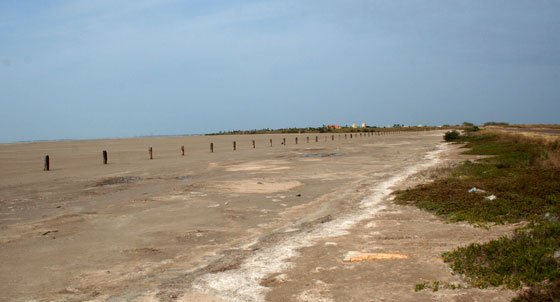Sheridan Bridge
The line of palmetto pilings just to the north of Highway 4 at Boca Chica Beach are the remains of a Union railroad built at the close of the Civil War. These posts were the foundations of a bridge that crossed the narrow Boca Chica inlet to connect Brazos Island to the mainland at White’s Ranch. When Union troops entered the Rio Grande delta in November 1863, they landed on Brazos Island and crossed the Boca Chica waterway using temporary floating pontoon bridges. After occupying Brownsville, Union General Francis Herron gave orders to build a railway and bridge that would transport troops and supplies to river steamboats which would carry them to points upriver. Union troops fell back to Brazos Island in spring 1864, scrapping plans for the line. When the Confederacy collapsed in May 1865 and Union forces re-entered Brownsville, the line again became a priority. General Philip Sheridan, commander of the Union Military Division of the Southwest, feared that Confederates who had fled to Mexico might stage attacks from across the border, perhaps in alliance with Mexican imperialist forces. Consequently he ordered completion of the railroad and bridge, which was constructed by U.S. Colored Troops. The line was a short lived one, however: the hurricane of 1867, which wiped out the towns of Bagdad, Clarksville, and the Brazos Santiago depot, also destroyed Sheridan's bridge.
It was never rebuilt.
Listen
La línea de pilotes de troncos de palma justo al norte de la carretera número 4 en la playa de Boca Chica son los restos de una vía férrea de la Unión construida hacia el final de la Guerra de Secesión estadounidense. Se trataba de las columnas que sostenían el puente a través del estrecho brazo de mar de Boca Chica para conectar la Isla de Brazos con la tierra firme en el Rancho White. Cuando las fuerzas unionistas entraron en el delta del Río Grande en noviembre de 1863, desembarcaron en dicha isla y salvaron el paso sobre las aguas utilizando un puente provisional de pontones flotantes. Después de ocupar Brownsville, el general unionista Francis Herron ordenó construir una vía férrea y un puente para acarrear tropas y suministros hasta los vapores que, a su vez, los transportarían río arriba. El posterior repliegue unionista hasta la Isla de Brazos en la primavera de 1864 desbarató estos planes aunque, cuando la Confederación se desmoronó en mayo de 1865 y las fuerzas unionistas reconquistaron Brownsville, el trazado de la vía férrea volvió a ser prioritario. El General Philip Sheridan, comandante en jefe de la División del Suroeste de las Fuerzas Armadas de la Unión, recelaba de que los confederados huidos a México pudieran plantar batalla cruzando la frontera, quizás aliados con las fuerzas imperialistas mexicanas, así que ordenó la finalización de la vía y del puente, que fueron construidos por el Regimiento Negro de los EE.UU. Pero el trazado tuvo una corta vida, pues el huracán de 1867, que arrasó las localidades de Bagdad, Clarksville, así como el polvorín de Brazos Santiago, también destruyó el puente de Sheridan, que no volvió a ser reconstruido.
Escucha
Details
Location: Boca Chica and end of HWY 4

